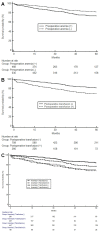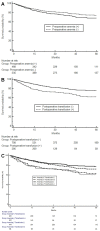Association of preoperative anemia and perioperative allogenic red blood cell transfusion with oncologic outcomes in patients with nonmetastatic colorectal cancer
- PMID: 31285680
- PMCID: PMC6588057
- DOI: 10.3747/co.26.4983
Association of preoperative anemia and perioperative allogenic red blood cell transfusion with oncologic outcomes in patients with nonmetastatic colorectal cancer
Abstract
Background: We investigated whether preoperative anemia and perioperative blood transfusion (pbt) are associated with overall survival and recurrence-free survival in patients with nonmetastatic colorectal cancer.
Methods: From 1 January 2009 to 31 December 2014, 1003 patients with primary colorectal cancer were enrolled in the study. Perioperative clinical and oncologic outcomes were analyzed based on the presence of preoperative anemia and pbt.
Results: Preoperative anemia was found in 468 patients (46.7%). In the anemia and no-anemia groups, pbt was performed in 44% and 15% of patients respectively. Independent predictors for pbt were preoperative anemia, higher American Society of Anesthesiologists score, laparotomy, lengthy operative time, advanced TNM stage, T4 stage, and 30-day morbidity. The use of pbt, but not preoperative anemia, was found to be an independent adverse prognostic factor for overall survival. In terms of recurrence-free survival, the presence of preoperative anemia was similarly not a significant prognostic factor, but the use of pbt was an independent factor for an unfavourable prognosis.
Conclusions: The use of pbt, but not preoperative anemia, was independently associated with worse overall and recurrence-free survival in nonmetastatic colorectal cancer. For better oncologic outcomes, our findings indicate a need to reduce the use of blood transfusion during the perioperative period.
Keywords: Colonic neoplasms; anemia; blood transfusions; rectal neoplasms; survival.
Conflict of interest statement
CONFLICT OF INTEREST DISCLOSURES We have read and understood Current Oncology’s policy on disclosing conflicts of interest, and we declare that we have none.
Figures


Similar articles
-
Impact of Perioperative Allogenic Blood Transfusion on Survival After Radical Nephroureterectomy for Upper Tract Urothelial Carcinoma.Clin Genitourin Cancer. 2016 Feb;14(1):96-104. doi: 10.1016/j.clgc.2015.10.003. Epub 2015 Oct 20. Clin Genitourin Cancer. 2016. PMID: 26506908
-
Perioperative Allogenic Blood Transfusion in Renal Cell Carcinoma: Risk Factors and Effect on Long-term Outcomes.Clin Genitourin Cancer. 2017 Jun;15(3):e421-e427. doi: 10.1016/j.clgc.2016.12.002. Epub 2016 Dec 29. Clin Genitourin Cancer. 2017. PMID: 28089722
-
Preoperative anemia and perioperative blood transfusion in head and neck squamous cell carcinoma.PLoS One. 2018 Oct 22;13(10):e0205712. doi: 10.1371/journal.pone.0205712. eCollection 2018. PLoS One. 2018. PMID: 30347001 Free PMC article.
-
Preoperative hemoglobin and perioperative blood transfusion in major head and neck surgery: a systematic review and meta-analysis.J Otolaryngol Head Neck Surg. 2023 Jan 24;52(1):3. doi: 10.1186/s40463-022-00588-4. J Otolaryngol Head Neck Surg. 2023. PMID: 36691071 Free PMC article.
-
Perioperative anemia management in colorectal cancer patients: a pragmatic approach.World J Gastroenterol. 2014 Feb 28;20(8):1972-85. doi: 10.3748/wjg.v20.i8.1972. World J Gastroenterol. 2014. PMID: 24587673 Free PMC article. Review.
Cited by
-
Need for preoperative anemia management clinics in Japan: initiatives at a university hospital in the USA.J Anesth. 2021 Oct;35(5):710-722. doi: 10.1007/s00540-021-02979-9. Epub 2021 Aug 2. J Anesth. 2021. PMID: 34338863
-
A novel prognostic model to predict OS and DFS of stage II/III gastric adenocarcinoma patients in China.Heliyon. 2022 Dec 30;8(12):e12403. doi: 10.1016/j.heliyon.2022.e12403. eCollection 2022 Dec. Heliyon. 2022. PMID: 36619400 Free PMC article.
-
The impact of perioperative red blood cell transfusion on the prognosis of colorectal cancer.Front Surg. 2022 Jul 21;9:927787. doi: 10.3389/fsurg.2022.927787. eCollection 2022. Front Surg. 2022. PMID: 35937600 Free PMC article.
-
Do Preoperative Transfusions Impact Prognosis in Moderate to Severe Anaemic Surgical Patients with Colon Cancer?Curr Oncol. 2021 Nov 12;28(6):4634-4644. doi: 10.3390/curroncol28060391. Curr Oncol. 2021. PMID: 34898556 Free PMC article.
-
Preoperative rectal tumor embolization as an adjunctive tool for bloodless abdominoperineal excision: A case report.World J Clin Oncol. 2020 Dec 24;11(12):1070-1075. doi: 10.5306/wjco.v11.i12.1070. World J Clin Oncol. 2020. PMID: 33437668 Free PMC article.
References
-
- Wan Kim Y. Surgical treatment for colorectal cancer in octogenarians and nonagenarians. J BUON. 2017;22:578–85. - PubMed
-
- World Health Organization (who) Haemoglobin Concentrations for the Diagnosis of Anaemia and Assessment of Severity. Geneva, Switzerland: who; 2011. [Available online at: http://www.who.int/vmnis/indicators/haemoglobin.pdf; cited 10 January 2019]
Publication types
MeSH terms
LinkOut - more resources
Full Text Sources
Medical

